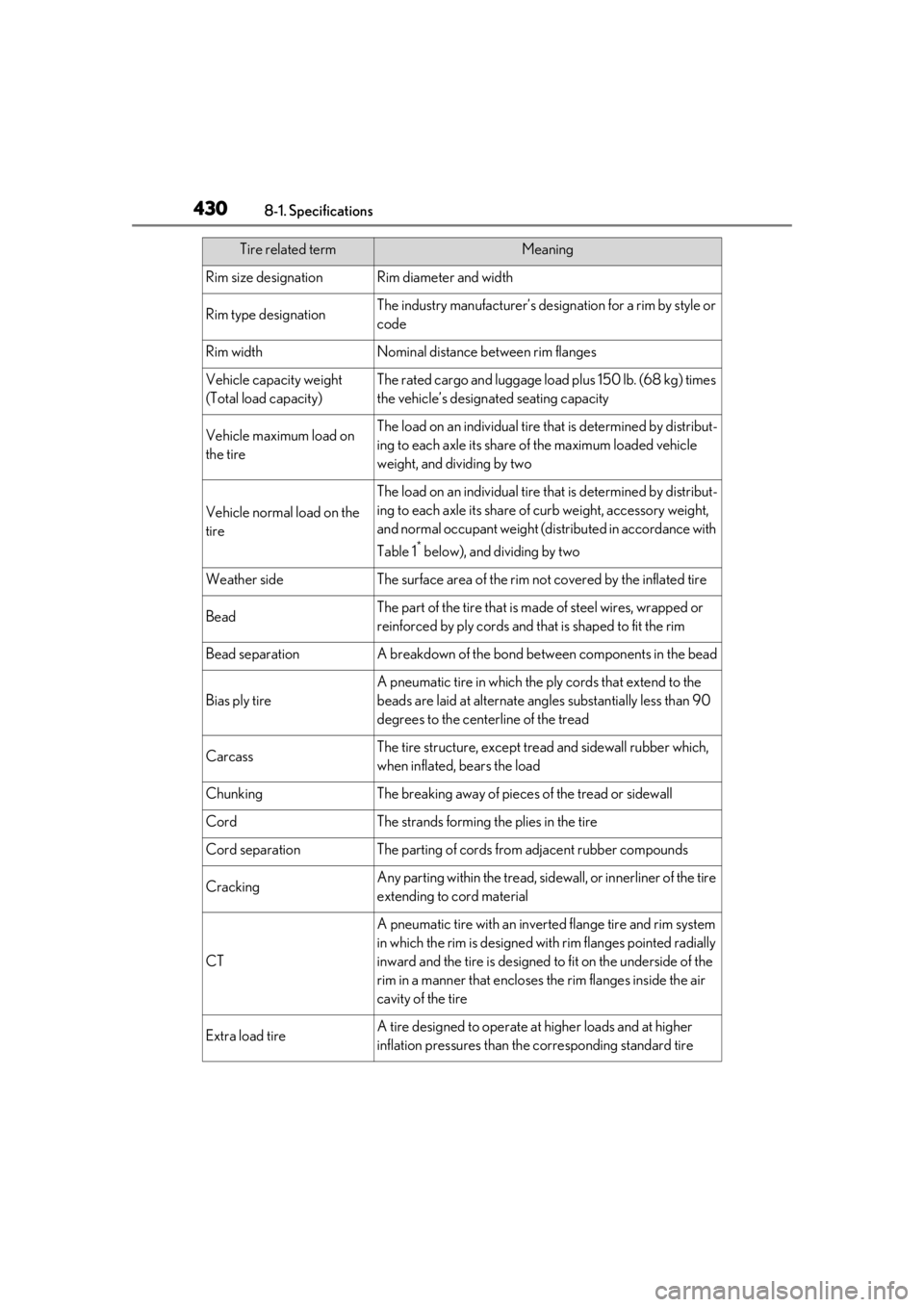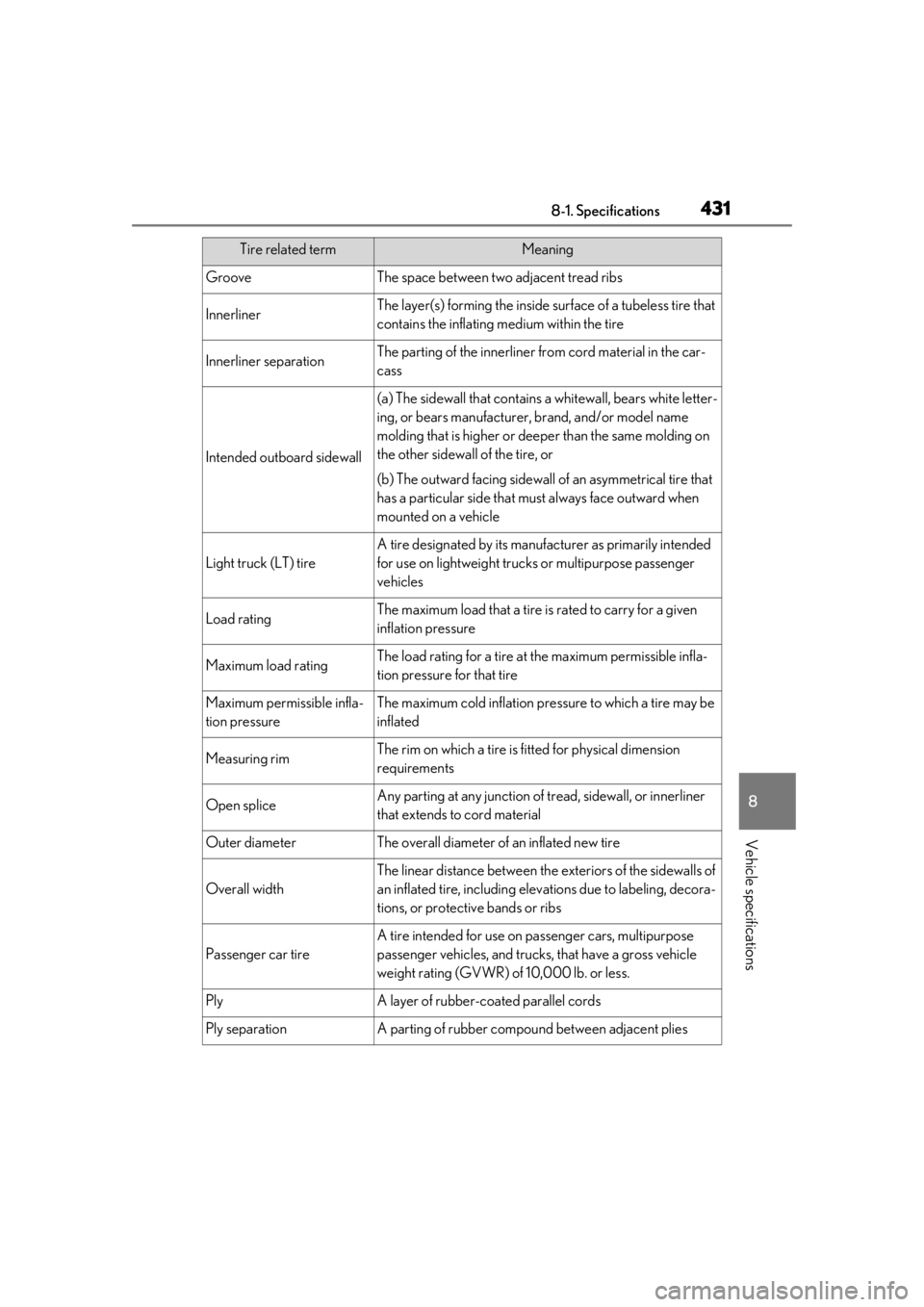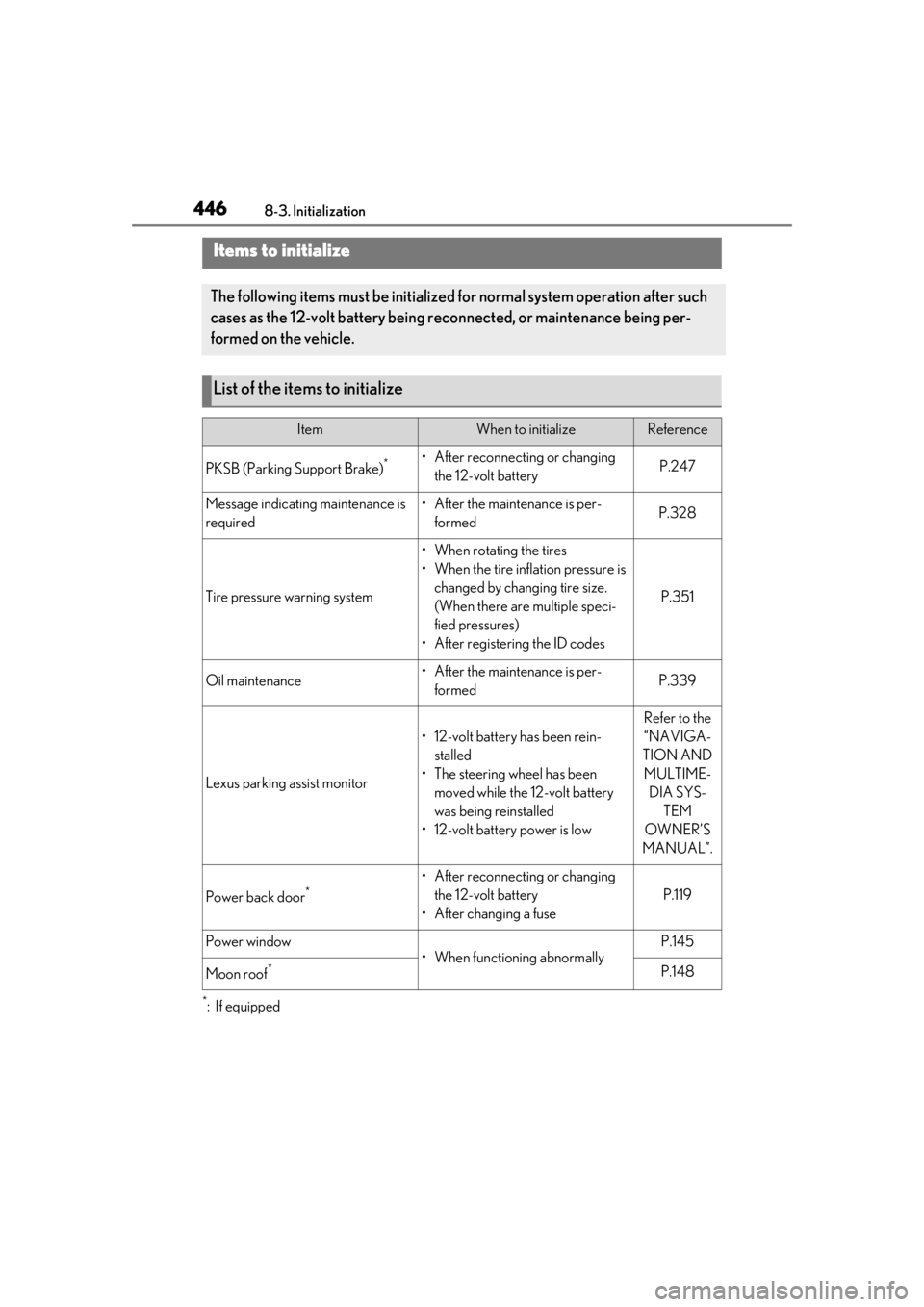2019 LEXUS UX250H flat tire
[x] Cancel search: flat tirePage 428 of 476

4288-1. Specifications
information.
■DOT quality grades
All passenger vehicle tires must con-
form to Federal Safety Requirements in
addition to these grades. Quality
grades can be found where applicable
on the tire sidewall between tread
shoulder and maximum section width.
For example: Treadwear 200 Traction AA
Temperature A
■Treadwear
The treadwear grade is a comparative
rating based on the wear rate of the tire
when tested under controlled condi-
tions on a specified government test
course.
For example, a tire graded 150 would wear
one and a half (1 - 1/2) times as well on the
government course as a tire graded 100.
The relative performa nce of tires depends
upon the actual conditions of their use,
however, and may depart significantly from
the norm due to variatio ns in driving habits,
service practices and differences in road
characteristics and climate.
■Traction AA, A, B, C
The traction grades, from highest to
lowest, are AA, A, B and C, and they
represent the tire’s ability to stop on
wet pavement as measured under con-
trolled conditions on specified govern-
ment test surfaces of asphalt and
concrete.
A tire marked C may have poor traction
performance.
Warning: The traction grade assigned to
this tire is based on braking (straight
ahead) traction tests and does not include
cornering (turning) traction.
■Temperature A, B, C
The temperature grades are A (the
highest), B, and C, representing the
tire’s resistance to the generation of
heat and its ability to dissipate heat
when tested under controlled condi-
tions on a specified indoor laboratory
test wheel.
Sustained high temperature can cause the
material of the tire to degenerate and
reduce tire life, and excessive temperature
can lead to sudd en tire failure.
Grade C corresponds to a level of perfor-
mance which all passenger car tires must
meet under the Fede ral Motor Vehicle
Safety Standard No. 109.
Grades B and A represent higher levels of
performance on the laboratory test wheel
than the minimum required by law.
Warning: The temperature grades for this
tire are established for a tire that is prop-
erly inflated and not overloaded.
Excessive speed, unde rinflation, or exces-
sive loading, either separately or in combi-
nation, can cause heat buildup and
possible tire failure.
Page 429 of 476

4298-1. Specifications
8
Vehicle specifications
Glossary of tire terminology
Tire related termMeaning
Cold tire inflation pressure
Tire pressure when the vehicle has been parked for three
hours or more, or has not been driven more than 1 mile or 1.5
km under that condition
Maximum inflation pressureThe maximum cold inflated pre ssure to which a tire may be
inflated, shown on th e sidewall of the tire
Recommended inflation
pressureCold tire inflation pressure recommended by a manufac-
turer
Accessory weight
The combined weight (in excess of those standard items
which may be replaced) of hybr id transmission, power steer-
ing, power brakes, power windows, power seats, radio and
heater, to the extent that these items are available as factory-
installed equipment (whether installed or not)
Curb weight
The weight of a motor vehicle with standard equipment,
including the maximum capacity of fuel, oil and coolant, and
if so equipped, air conditio ning and additional weight
optional engine
Maximum loaded vehicle
weight
The sum of:
(a) Curb weight
(b) Accessory weight
(c) Vehicle capacity weight
(d) Production options weight
Normal occupant weight150 lb. (68 kg) times the number of occupants specified in
the second column of Table 1
* that follows
Occupant distributionDistribution of occupants in a ve hicle as specified in the third
column of Table 1
* below
Production options weight
The combined weight of in stalled regular production
options weighing over 5 lb. (2.3 kg) in excess of the stan-
dard items which they replace, not previously considered in
curb weight or accessory we ight, including heavy duty
brakes, ride levelers, roof r ack, heavy duty 12-volt battery,
and special trim
RimA metal support for a tire or a tire and tube assembly upon
which the tire beads are seated
Rim diameter
(Wheel diameter)Nominal diameter of the bead seat
Page 430 of 476

4308-1. Specifications
Rim size designationRim diameter and width
Rim type designationThe industry manufacturer’s designation for a rim by style or
code
Rim widthNominal distance between rim flanges
Vehicle capacity weight
(Total load capacity)The rated cargo and luggage load plus 150 lb. (68 kg) times
the vehicle’s designated seating capacity
Vehicle maximum load on
the tireThe load on an individual tire that is determined by distribut-
ing to each axle its share of the maximum loaded vehicle
weight, and dividing by two
Vehicle normal load on the
tire
The load on an individual tire that is determined by distribut-
ing to each axle its share of curb weight, accessory weight,
and normal occupant weight (distributed in accordance with
Table 1
* below), and dividing by two
Weather sideThe surface area of the rim not covered by the inflated tire
BeadThe part of the tire that is ma de of steel wires, wrapped or
reinforced by ply cords and th at is shaped to fit the rim
Bead separationA breakdown of the bond between components in the bead
Bias ply tire
A pneumatic tire in which the ply cords that extend to the
beads are laid at alternate angles substantially less than 90
degrees to the centerline of the tread
CarcassThe tire structure, except tread and sidewall rubber which,
when inflated, bears the load
ChunkingThe breaking away of pieces of the tread or sidewall
CordThe strands forming the plies in the tire
Cord separationThe parting of cords from adjacent rubber compounds
CrackingAny parting within the tread, side wall, or innerliner of the tire
extending to cord material
CT
A pneumatic tire with an inverted flange tire and rim system
in which the rim is designed wi th rim flanges pointed radially
inward and the tire is designed to fit on the underside of the
rim in a manner that encloses the rim flanges inside the air
cavity of the tire
Extra load tireA tire designed to operate at higher loads and at higher
inflation pressures than the corresponding standard tire
Tire related termMeaning
Page 431 of 476

4318-1. Specifications
8
Vehicle specifications
GrooveThe space between two adjacent tread ribs
InnerlinerThe layer(s) forming the inside surface of a tubeless tire that
contains the inflating medium within the tire
Innerliner separationThe parting of the innerliner fr om cord material in the car-
cass
Intended outboard sidewall
(a) The sidewall that contains a whitewall, bears white letter-
ing, or bears manufacturer, brand, and/or model name
molding that is higher or deep er than the same molding on
the other sidewall of the tire, or
(b) The outward facing sidewall of an asymmetrical tire that
has a particular side that must always face outward when
mounted on a vehicle
Light truck (LT) tire
A tire designated by its manuf acturer as primarily intended
for use on lightweight trucks or multipurpose passenger
vehicles
Load ratingThe maximum load that a tire is rated to carry for a given
inflation pressure
Maximum load ratingThe load rating for a tire at the maximum permissible infla-
tion pressure for that tire
Maximum permissible infla-
tion pressureThe maximum cold inflation pre ssure to which a tire may be
inflated
Measuring rimThe rim on which a tire is fitted for physical dimension
requirements
Open spliceAny parting at any junction of tread, sidewall, or innerliner
that extends to cord material
Outer diameterThe overall diameter of an inflated new tire
Overall width
The linear distance between the exteriors of the sidewalls of
an inflated tire, including elev ations due to labeling, decora-
tions, or protective bands or ribs
Passenger car tire
A tire intended for use on passenger cars, multipurpose
passenger vehicles, and trucks, that have a gross vehicle
weight rating (GVWR) of 10,000 lb. or less.
PlyA layer of rubber-coated parallel cords
Ply separationA parting of rubber compound between adjacent plies
Tire related termMeaning
Page 432 of 476

4328-1. Specifications
*:Table 1 Occupant loading and distribution for vehicle normal load for various desig-
nated seating capacities
Pneumatic tire
A mechanical device made of rubber, chemicals, fabric and
steel or other materials, that, when mounted on an automo-
tive wheel, provides the traction and contains the gas or fluid
that sustains the load
Radial ply tire
A pneumatic tire in which the ply cords that extend to the
beads are laid at substantiall y 90 degrees to the centerline
of the tread
Reinforced tireA tire designed to operate at higher loads and at higher
inflation pressures than the corresponding standard tire
Section width
The linear distance between the exteriors of the sidewalls of
an inflated tire, excluding elevations due to labeling, decora-
tion, or protective bands
SidewallThat portion of a tire between the tread and bead
Sidewall separationThe parting of the rubber comp ound from the cord material
in the sidewall
Snow tire
A tire that attains a traction index equal to or greater than
110, compared to the ASTM E-1136 Standard Reference
Test Tire, when using the snow traction test as described in
ASTM F-1805-00, Standard Test Method for Single Wheel
Driving Traction in a Straight Line on Snow-and Ice-Cov-
ered Surfaces, and which is ma rked with an Alpine Symbol
( ) on at least one sidewall
Test rimThe rim on which a tire is fitt ed for testing, and may be any
rim listed as appropriate for use with that tire
TreadThat portion of a tire that comes into contact with the road
Tread ribA tread section running circ umferentially around a tire
Tread separationPulling away of the tread from the tire carcass
Treadwear indicators (TWI)The projections within the principal grooves designed to
give a visual indication of the degrees of wear of the tread
Wheel-holding fixtureThe fixture used to hold the wheel and tire assembly
securely during testing
Tire related termMeaning
Page 446 of 476

4468-3. Initialization
8-3.Initialization
*:If equipped
Items to initialize
The following items must be initialized for normal system operation after such
cases as the 12-volt battery being re connected, or maintenance being per-
formed on the vehicle.
List of the items to initialize
ItemWhen to initializeReference
PKSB (Parking Support Brake)*• After reconnecting or changing the 12-volt batteryP.247
Message indicating maintenance is
required• After the maintenance is per-formedP.328
Tire pressure warning system
• When rotating the tires
• When the tire inflation pressure is changed by changing tire size.
(When there are multiple speci-
fied pressures)
• After registering the ID codes
P.351
Oil maintenance• After the maintenance is per- formedP.339
Lexus parking assist monitor
• 12-volt battery has been rein-stalled
• The steering wheel has been moved while the 12-volt battery
was being reinstalled
• 12-volt battery power is low
Refer to the
“NAVIGA-
TION AND MULTIME- DIA SYS- TEM
OWNER’S
MANUAL”.
Power back door*• After reconnecting or changing the 12-volt battery
• After changing a fuse
P.119
Power window
• When functioning abnormally
P.145
Moon roof*P.148
Page 461 of 476

461What to do if... (Troubleshooting)
If you cannot release the shift lever
by depressing the brake pedal with
the power switch in ON (P.168)
It is locked automatically to prevent
theft of the vehicle. ( P.163)
Is the window lock switch pressed?
The power window except for the
one at the driver’s seat cannot be
operated if the window lock switch
is pressed. ( P.146)
The auto power off function will be
operated if the vehicle is left in ACC
or ON (the hybrid system is not
operating) for a period of time.
( P.164)
The seat belt reminder light is flash-
ing
Are the driver and the front passen-
ger wearing the seat belts?
( P.390)
The parking brake indicator is on
Is the parking brake released?
( P.172) Depending on the situation, other
types of warning buzzer may also
sound. (
P.386, 395)
Did anyone inside the vehicle open
a door during setting the alarm?
The sensor detects it and the alarm
sounds. ( P.71)
To stop the alarm, turn the power
switch to ON or start the hybrid sys-
tem.
Is the message displayed on the
multi-information display?
Check the message on the multi-
information display. ( P.395)
When a warning light turns on or a
warning message is displayed, refer
to P.386, 395.
Slow down the vehicle, drive with
extra caution, and take your vehicle
to the nearest Lexus dealer or
authorized tire dealer as soon as
The steering wheel cannot be
turned after the hybrid system is
stopped
The windows do not open or
close by operating the power
window switches
The power switch is turned off
automatically
A warning buzzer sounds during
drivingAn alarm is activated and the
horn sounds
A warning buzzer sounds when
leaving the vehicle
A warning light turns on or a
warning message is displayed
When a problem has occurred
If you have a flat tire
Page 465 of 476

Alphabetical Index465
Head-up display ........................................... 93
Intuitive parking assist.............................. 232
LTA (Lane-Tracing Assist) .....................210
Multi-information display .......................... 87
RCTA .............................................................. 239
Warning messages ..................................395
Distance until next engine oil change .. 80, 86
Do-it-yourself maintenance .................... 333
Door lock Doors................................................................ 108
Smart access system with push-button start .................................................................. 124
Wireless remote control......................... 106
Doors Automatic door lock ing and unlocking
system ............................................................... 111
Back door..........................................................112
Door glasses ..................................................145
Door lock........................................................ 108
Open door warning bu zzer .......... 109, 111
Outside rear view mirrors ...................... 142
Rear door child-protectors ....................... 111
Side doors ...................................................... 108
Drive distance .................................................. 89
Drive info 1/Drive info 2 .............................. 89
Driver’s seat position memory .................133
Drive-start control ........................................152
Driving................................................................152 Break-in tips ...................................................153
Correct driving posture ............................ 25
Driving mode select switch .................. 255
Hybrid vehicle driving tips ...................... 261
Procedures .....................................................152
Winter drive tips......................................... 263
Driving information display ........................ 88
Driving position memory............................133 Memory recall function ............................135
Driving range ................................................... 89
Driving support system information display ............................................................................. 90
Dynamic radar cruise control with full- speed range..................................................216
Warning message .........................224, 395
E
ECB (Electronically Controlled Brake Sys-
tem) ................................................................ 256
Eco drive mode ............................................ 255
EDR (Event data recorder) ........................... 8
E-Four .............................................................. 257
Elapsed time ..................................................... 89
Electric motor Location ............................................................. 62
Electric Power Steering (EPS) Function .......................................................... 257
Warning light .............................................. 388
Electronically Controlled Brake System (ECB) ............................................................ 256
Electronic key ................................................ 104 Battery-saving function............................ 125
If the electronic key does not operate properly ...................................................... 403
Replacing the battery .............................. 368
Emergency, in case of If a warning buzzer sounds.................. 386
If a warning light turns on...................... 386
If a warning message is displayed .... 395
If the 12-volt battery is discharged ... 405
If the electronic key does not operate properly ...................................................... 403
If the fuel filler do or cannot be opened
..........................................................................402
If the hybrid system will not start ....... 400
If the vehicle is trapped in rising water .......................................................................... 379
If you have a flat tire ................................. 399
If you lose your keys .................................402
If you think something is wrong......... 385
If your vehicle becomes stuck ...............413
If your vehicle has to be stopped in an emergency .................................................378
If your vehicle needs to be towed ...... 381
If your vehicle overheats ......................... 410